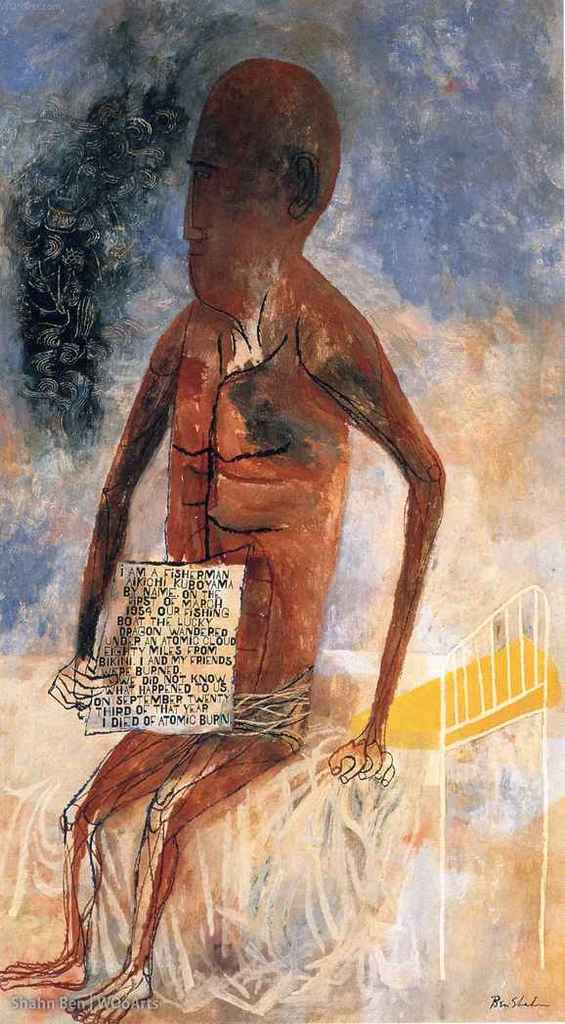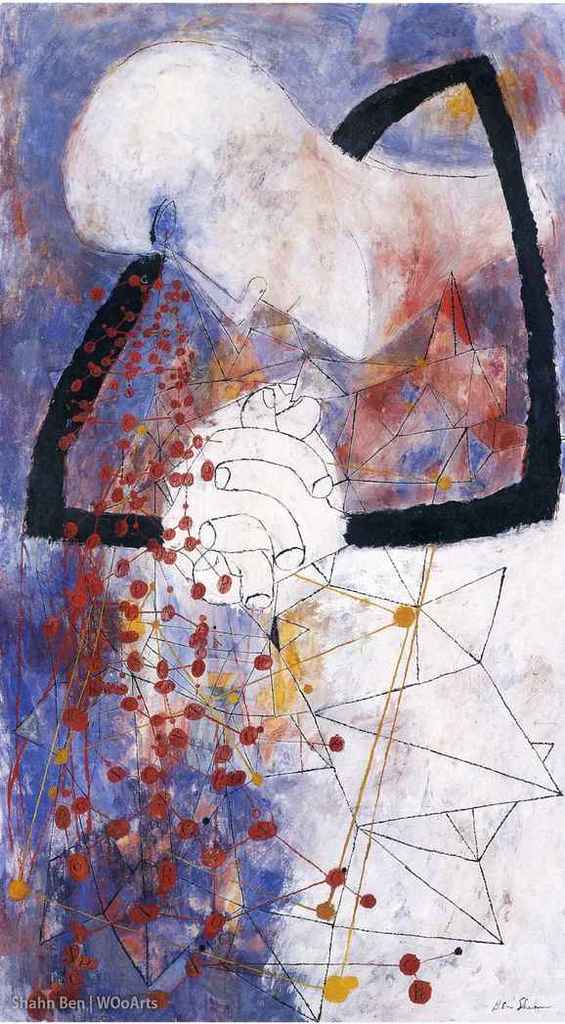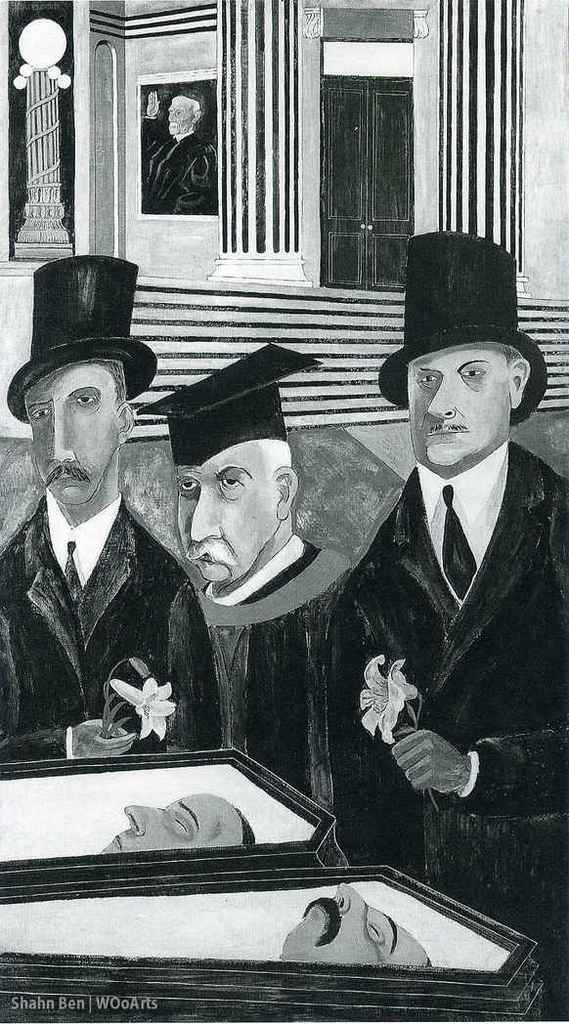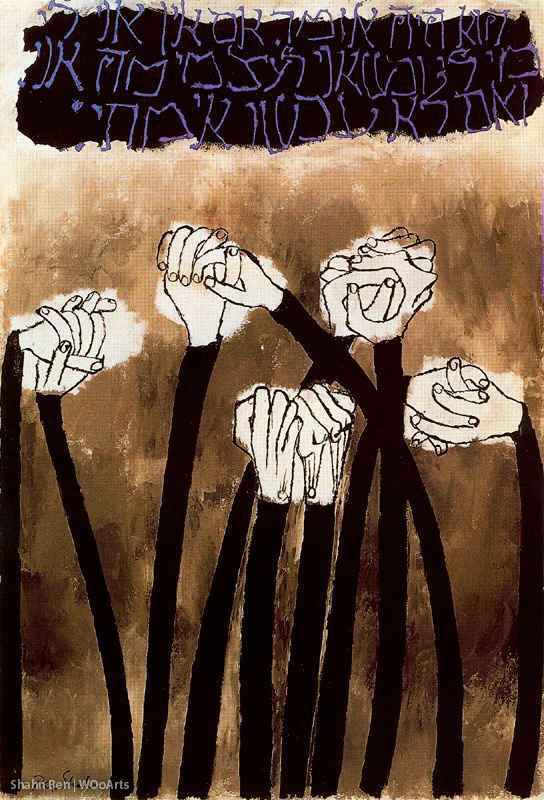Ben Shahn’s desire to create narrative art that focuses on social and political justice have come to exemplify Social Realism and the art of social consciousness. From his questioning religious teachings as a youth in Lithuania and up through the end of his life, Shahn remained true to his vision. He never failed to create artwork to draw attention to those for whom life was a struggle, and did so with dignity rather than pathos or sentimentality.
Key Ideas
Prior to World War II, Shahn was a lead practitioner of what has come to be called Social Realism. Such art works are narrative, figurative, and illustrative of the poor, oppressed, or those who live at the margins of society. The guiding spirit of Social Realism is a commitment to humanism.
Ben Shahn brought together different forms of visual culture to break down the barrier between mass media and fine art. In opposition to what Shahn called “the rules for pure art,” the artist consistently inserted words, texts, and quotations into his artwork to emphasize the didactic nature of his art.
Because of Shahn’s apprenticeship and friendship with Diego Rivera, Frida Kahlo, and other prominent artists, he upheld the supremacy and universality of art over the false boundaries of nation states. Through his work with Rivera, Shahn serves as a conduit between the United States and the arts of Mexico which were all the rage in the 1920s and 1930s, but fell out of favor until its revival in the 1980s.
Despite his rise in fame and prestige, Shahn remained committed to his audience and subject matter. Shahn never spoke down to the American people, rather he stood amongst the crowd and fought the same fights as they did.
The Passion of Sacco and Vanzetti (1931-32)
This is the only easel painting out of Ben Shahn’s series of twenty-three gouaches depicting elements of the trial and subsequent execution of the two Italian immigrants, Nicola Sacco and Bartolomeo Vanzetti who were accused of murder during a robbery in Massachusetts. At the time and still today, controversy surrounds the guilty verdict, with many believing that the men were condemned because they were anarchists and because of the overt anti-immigrant sentiments of the era. In this painting, the three members of the Lowell Committee who denied the defendants’ appeal hold lilies as they stand over open coffins containing the bodies of Sacco and Vanzetti. Judge Thayer can be seen in the background staring out the courthouse window onto the scene.
Shahn submitted this easel painting to an exhibition organized by Lincoln Kirstein at the Museum of Modern Art in New York. The museum’s Board of Trustees objected to Shahn’s depiction of the Lowell Committee members who were friends to many of the museum’s trustees. Despite the Board’s demand that Shahn’s works along with the equally objectionable works by Hugo Gellert and William Gropper not be shown, the many other artists in the exhibition and the curator Kirstein refused to participate if the three artists were banned. The show eventually moved forward including Shahn’s work with many of the trustees resigning in anger.
The painting’s topic provides an early example of Shahn’s use of his art against social injustice. This work helped to establish him as one of the great Social Realist painters. Also in the development of this artwork, Shahn had begun to think sequentially about narration through art, a process which ultimately led him to paint his complex public murals.
Rather than painting for himself as other modernists did, Shahn painted for the public and for the cause of Sacco and Vanzetti, while simultaneously drawing upon the cubistic forms of Picasso in his figures. Shahn successfully melds together the formal with the political in this work.
Tempera on canvas – Collection of Whitney Museum of American Art, New York, New York
Source: theartstory.org
Ben Shahn was an American artist and member of the Social Realist movement. His expressive figurative paintings, murals, and posters were inexorably tied to his lifelong activism and pursuit of social justice within his left-wing political beliefs. Frequently featuring scenes of the inequality and hardships faced by the working classes in the United States, Shahn unflinchingly portrayed the important political events of his day, as seen in his The Passion of Sacco and Vanzetti (1931–1932), a painting about the controversial conviction of two Italian-American immigrants who were sentenced to death in 1927.
Born Benjamin Shahn on September 12, 1898 in Kaunas, Lithuania, he studied at the National Academy of Design in New York, NY and traveled throughout Europe during the 1920s. Upon his return to the United States, he assisted Diego Rivera in 1933 for the painting of his Man at the Crossroads fresco in Rockefeller Center before being commissioned to create his own at the Federal Security Building and the Bronx Central Annex Post Office. The artist died March 14, 1969 in New York, NY at the age of 70.
Source: artnet.com
Ben Shahn (September 12, 1898 – March 14, 1969) was a Lithuanian-born American artist. He is best known for his works of social realism, his left-wing political views, and his series of lectures published as The Shape of Content.
Biography
Shahn was born in Kaunas, Lithuania, then occupied by the Russian Empire, to Jewish parents Joshua Hessel and Gittel (Lieberman) Shahn. His father was exiled to Siberia for possible revolutionary activities in 1902, at which point Shahn, his mother, and two younger siblings moved to Vilkomir (Ukmergė). In 1906, the family immigrated to the United States where they rejoined Hessel, who had fled Siberia. They settled in the Williamsburg section of Brooklyn, New York, where two more siblings were born. His younger brother drowned at age 17.
Shahn began his path to becoming an artist in New York, where he was first trained as a lithographer. Shahn’s early experiences with lithography and graphic design is apparent in his later prints and paintings which often include the combination of text and image. Shahn’s primary medium was egg tempera, popular among social realists.
Although Shahn attended New York University as a biology student in 1919, he went on to pursue art at City College in 1921 and then at the National Academy of Design.
After his marriage to Tillie Goldstein in 1924, the two traveled through North Africa and then to Europe, where he made “the traditional artist pilgrimage.” There he studied great European artists such as Henri Matisse, Raoul Dufy, Georges Rouault, Pablo Picasso and Paul Klee. Contemporaries who would make a profound impact on Shahn’s work and career include artists Walker Evans, Diego Rivera and Jean Charlot.
Shahn was dissatisfied with the work inspired by his travels, claiming that the pieces were unoriginal. Shahn eventually outgrew his pursuit of European modern art, and redirected his efforts toward a realist style which he used to contribute to social dialogue.
The twenty-three gouache paintings of the trials of Sacco and Vanzetti communicated the political concerns of his time, rejecting academic prescriptions for subject matter. The Passion of Sacco and Vanzetti was exhibited in 1932 and received acclaim from both the public and critics. This series gave Shahn the confidence to cultivate his personal style, regardless of society’s art standards.
Source: wikipedia.org
Gallery

View Ben Shahn Painting Gallery














